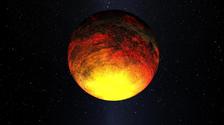Artist's impression of the exoplanet Kepler-10b that is slightly more massive than Earth. (Credit: NASA [Source])
The research unit “Matter Under Planetary Interior Conditions”, led by the University of Rostock and including scientists from DESY will find out more about exoplanets in the framework of a grant funded by the German Research Foundation (DFG). With the help of telescopes on Earth and in space, several thousand planets outside of our solar system have been discovered since 1996. Observation data such as mass, radius, and distance from their central star give only a few details about the composition and origin of these exoplanets. Therefore, the interdisciplinary collaboration plans theory, planetary modelling, and experiments. This comprises experimental investigations of materials under extreme conditions, such as those found inside of planets. The DFG will fund the project for the next three years with a total contribution of around two million euros.
“A strength of our proposal is that it combines theory, planetary modelling, and experiments in order to learn more about the composition and development of planets inside and outside of our solar system”, says Prof. Ronald Redmer of the University of Rostock, spokesperson for the research unit. In addition, the findings will be used for the evaluation of observation data from satellite missions.
The Kepler Space Telescope has discovered a large number of planets between one and twenty times the mass of the Earth in orbits close to Sun-like stars. These exoplanets are defined as so-called “super-Earths”, which have a similar density and masses up to ten times that of the Earth, and neptunian planets, which have a similar density as the planet Neptune in our solar system. Neptune has a solid core; a mantle composed of liquid water, ammonia, and methane; as well as an atmosphere made of hydrogen, helium, and methane. In the interiors of all of these types of planets pressures can be many times higher than those inside the Earth and temperatures can reach several thousand degrees Celsius. The researchers want to find out how the principal constituents of these planets—for example, magnesium oxide and silicates for super-Earths as well as planetary ices like water, methane, and ammonia for neptunian planets—behave under these conditions.
At DESY's Extreme Conditions Beamline (ECB), located at DESY's high-intensity X-ray source PETRA III, material samples can be analysed at extremely high pressures and temperatures. "The Extreme Conditions Beamline is ideally suited to investigate the structure of magnesium oxide and silicates as well as planetary ices by means of X-ray diffraction under the pressure and temperature conditions of a planet's interior," explains DESY researcher Hanns-Peter Liermann, ECB beamline manager and Co-principal investigator for two subprojects of the research group. "To produce a pressure of four to ten million atmospheres and temperatures of more than 4500 degrees Celsius, we will use new types of so-called diamond anvil cells in which resistive heating and laser radiation can be employed to heat the samples."
Diamant anvil cells (DAC) compress the sample between two small diamond anvils with extremely high pressure. For the investigation of oxides and silicates, the researchers use a double stage DAC (dsDAC), developed by Leonid Dubrovinsky at the Bavarian Geoinstitut at the University of Bayreuth, who is the principal investigator of this subproject. With around ten million atmospheres, the dsDAC holds the record for the highest static pressures in metals worldwide. "In order to solve the structure of oxides and silicates under these high pressures, a very fine X-ray beam is needed since the compressed sample between the two diamonds is very small," explains Liermann. Both the ECB and the nanofocussing beamline P06 at PETRA III offer this beam quality.
The inner structure of planetary ices, on the other hand, is examined in a dynamic diamond anvil cell (dDAC) that can produce a pressure of up to four million atmospheres. "We will carry out our experiments on extremely short time scales and thus achieve unprecedented pressures and temperatures," explains Hauke Marquardt of the Bavarian Geoinstitute, principal investigator of this subproject. In order to be able to carry out the experiments quickly, Marquardt and Liermann will use the strong and focused X-ray beam of the ECB.
During the second half of the project, the scientists will also use the High-Energy-Density Instrument (HED) of the European X-ray laser Eurpean XFEL, which is currently being put into operation. With its ultra-short flashes, the X-ray laser will enable the scientists to gain information about the structure of the planetary materials even more rapidly - and thus before the diamonds in the anvil cell are destroyed.
Other than the Universities of Rostock and Bayreuth, European XFEL and DESY, the Institute for Planetary Research of the German aeronautics and space research centre DLR in Berlin is also participating.
(from DESY News)







